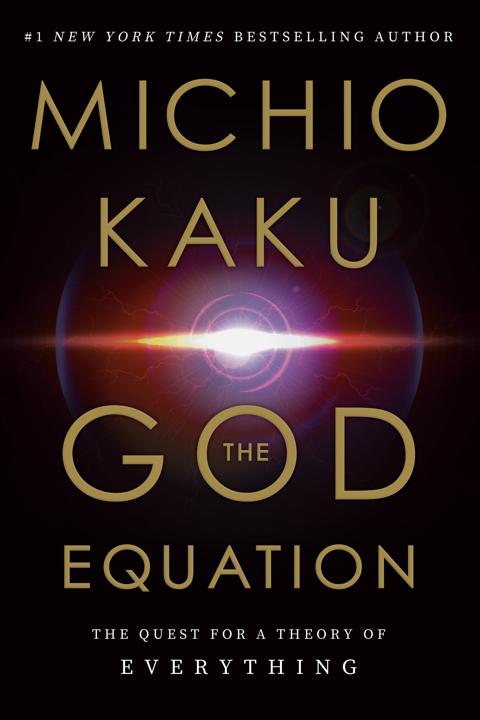Last updated on 2025/04/22
The God Equation Summary
Michio Kaku
The quest for the universe's ultimate theory
Last updated on 2025/04/22
The God Equation Summary
Michio Kaku
The quest for the universe's ultimate theory
Description

How many pages in The God Equation?
225 pages
What is the release date for The God Equation?
Embark on a captivating journey to uncover the universe's deepest secrets with Michio Kaku's 'The God Equation,' a riveting exploration into the quest for a unified theory of everything. Through engaging storytelling and clear explanations, Kaku guides readers through the complex world of physics, revealing how scientists aim to unify the fundamental forces that govern our cosmos. Whether you're a seasoned science enthusiast or a curious newcomer, this book invites you to ponder profound questions about the nature of reality and humanity's relentless pursuit to understand the universe at its most fundamental level.
Author Michio Kaku
Michio Kaku is a distinguished theoretical physicist, futurist, and science communicator known for his ability to popularize complex scientific concepts. As a professor at the City College of New York and a pioneering researcher in string theory, Kaku has authored numerous books and appeared in various documentaries, earning him recognition as one of the most influential science communicators of our time. His work often explores the frontiers of physics and the potential future of technology, inspiring many with his engaging insights into the universe.
The God Equation Summary |Free PDF Download
The God Equation
Chapter 1 | UNIFICATION—THE ANCIENT DREAM
Introduction to Unification and Ancient Philosophies The chapter begins by exploring humanity's age-old quest to find a grand design or underlying order in the universe, referencing ancient Greek philosophies. Democritus's concept of indivisible atoms and Pythagoras's mathematical description of musical resonances laid early groundwork for understanding natural complexity. The Dark Ages and Scientific Revival Following the fall of classical civilization, scientific inquiry was suppressed, replaced by superstition. The Renaissance rekindled scientific pursuits, with figures like Kepler, Bruno, and Galileo challenging dogmas through observation and mathematics, ultimately leading to Newton’s groundbreaking theories. Newton’s Unification of Physics Isaac Newton unified terrestrial and celestial mechanics by proposing universal laws of gravity, demonstrating that the same force governing apples falling also kept the moon in orbit. His laws revolutionized science, enabling precise predictions of celestial bodies like Neptune. Symmetry and Conservation Laws Newton’s equations exhibit symmetry, meaning physical laws remain invariant under various transformations. This principle hints at deeper, underlying symmetries in the universe, fundamental to the pursuit of a unified field theory. Impact of Newton’s Laws and Further Scientific Advances Newton’s principles underpin modern engineering, helping design everything from skyscrapers to engines. Later, discoveries in electricity and magnetism by Faraday and Maxwell unveiled the electromagnetic force, shaping technology and our understanding of light. Electromagnetism and Light Maxwell unified electricity and magnetism into a cohesive theory, predicting electromagnetic waves traveling at the speed of light—identifying light itself as an electromagnetic phenomenon. Maxwell’s equations underpin modern communications technologies. Electromagnetic Spectrum and Human Perception The electromagnetic spectrum extends beyond visible light into radio waves, infrared, ultraviolet, and more. Our eyes perceive only a narrow band, with other wavelengths invisible yet vital for various applications, including animal vision and technological devices. Development of Wireless Communication and Power Scientists like Hertz and Marconi harnessed electromagnetic waves for wireless communication, revolutionizing information transfer and power distribution. These advances are grounded in Maxwell’s theory and field concepts. The Foundations and Limitations of Classical Physics By 1900, physics seemed complete with Newton and Maxwell’s theories, but they were fundamentally incompatible, hinting at the need for a new, more encompassing framework. The chapter concludes by introducing a young physicist born in 1879, poised to resolve these contradictions.
Key Point: The quest for a unified understanding of the universe is a timeless human pursuit.
Critical Interpretation: Embracing the idea that we are part of an ongoing journey to comprehend the cosmos inspires us to seek connections in our own lives, fostering a mindset of curiosity and interconnectedness that can lead to personal growth and greater appreciation of the universe's mysteries.
Chapter 2 | EINSTEIN’S QUEST FOR UNIFICATION
Einstein's Childhood Question and Background As a teenager, Einstein wondered if he could outrun a light beam, a question that would lead to his development of the theory of relativity. Despite initial struggles and being considered a failure by some, he found employment at the Bern patent office, where he rekindled his curiosity about light and physics. The Discovery of Special Relativity While studying Maxwell's equations, Einstein realized that the speed of light remains constant regardless of the observer's motion. This insight led him to conclude that space and time are flexible, resulting in the concepts of time dilation and length contraction, which are foundational to special relativity. Implications of Relativity and Symmetry in Physics Einstein demonstrated that the laws of physics are invariant under transformations in four-dimensional spacetime, unifying space and time. He emphasized that equations with symmetrical properties are considered beautiful and fundamental, highlighting the importance of symmetry in understanding the universe. From Special to General Relativity and the Nature of Gravity Einstein extended his theories to include gravity by developing general relativity, where gravity is described as the curvature of spacetime caused by mass and energy. This contrasts with Newton’s view of gravity as a force acting at a distance. Einstein used thought experiments, such as falling elevators and curved surfaces, to develop his ideas. Experimental Confirmations and the Impact of Einstein’s Theories Key experiments, like the observation of Mercury's orbit and the bending of light during solar eclipses, confirmed Einstein’s predictions. The 1919 solar eclipse expedition provided strong evidence for gravitational light deflection, elevating Einstein to global fame and earning him the Nobel Prize. Modern Applications and the Quest for Unification The GPS system relies on Einstein’s relativity to function accurately, accounting for time changes due to speed and gravity. Einstein sought a unifying theory that would combine all fundamental forces, but his efforts were hindered by the emerging field of quantum mechanics, which he critiqued despite being a pioneer of the quantum theory. Characteristics Shared by Newton and Einstein, and Their Legacies Both physicists displayed intense focus and visualization skills. While Newtonian physics portrayed a static universe with forces acting at a distance, Einstein described a universe where space is curved, and gravity results from this curvature, revolutionizing our understanding of the cosmos.
Key Point: The importance of curiosity and questioning in driving scientific discovery.
Critical Interpretation: Your innate curiosity can serve as a powerful catalyst for innovation and understanding. Just as Einstein's childhood question about outrunning a light beam led to groundbreaking theories, nurturing your curiosity can unlock new perspectives and inspire personal and intellectual growth.
Chapter 3 | RISE OF THE QUANTUM
Evolution of Matter and Early Discoveries The chapter explores the centuries-long quest to understand what matter is made of, beginning with Newton's experiments and later developments like Mendeleyev's periodic table, which revealed patterns among elements. It discusses discoveries of unstable elements like radium by the Curies, which challenged the idea of eternal elements and opened the door to nuclear physics. Atomic Structure and Quantum Insights Experiments by Rutherford revealed atoms are mostly empty space, leading to the nuclear model. Further discoveries identified subatomic particles—protons, neutrons, and electrons—and their behaviors, which could not be explained by classical physics. These findings prompted the development of quantum mechanics to understand atomic and subatomic phenomena. Quantum Mechanics and Wave-Particle Duality Quantum theory introduced the concept that particles like electrons exhibit wave-like behaviors, as demonstrated by double-slit experiments. Schrödinger's wave equation successfully modeled atomic behavior, explaining electron shells and the periodic table. The theory also predicted antimatter and introduced the idea of probability waves, challenging classical notions of determinism. Relativistic Quantum Theories and Spin The Schrödinger equation's limitations led Paul Dirac to formulate a relativistic wave equation, predicting properties like electron spin and antimatter. These concepts, including symmetry in physics, revolutionized understanding of subatomic particles and fundamental forces. Philosophical Implications and Debates The chapter discusses the philosophical debates between Einstein and Bohr over the interpretation of quantum mechanics, especially concepts like wavefunction collapse and indeterminacy. Thought experiments like Schrödinger's cat illustrate these profound debates about reality and observation. The Sun's Energy and Nuclear Fusion Scientists used spectral analysis to determine that the sun is mainly composed of hydrogen, with processes like nuclear fusion converting hydrogen into helium, releasing vast amounts of energy as described by Einstein's E=mc^2. This insight connected atomic physics to stellar processes. Impact of World War II and Atomic Energy The rise of Nazi Germany led to the exodus of brilliant physicists and the development of nuclear weapons. The Manhattan Project, spurred by concerns over Nazi atomic ambitions, resulted in the creation of the atomic bomb, highlighting the profound connection between quantum physics and technological power. Continuing Quest for a Unified Theory Post-war, physicists returned to the challenge of developing a complete quantum theory of matter, seeking to unify quantum mechanics with other fundamental theories to understand the universe at all scales.
Key Point: The chapter highlights how our understanding of matter—from atoms to subatomic particles—has evolved through curiosity and scientific discovery.
Critical Interpretation: This reminds us that continuous exploration and questioning lead to profound insights about the universe, inspiring us to stay curious and open-minded in our own pursuits.
Chapter 4 | THEORY OF ALMOST EVERYTHING
Overview of Postwar Physics and Einstein's Quest After World War II, Einstein, famed for his theories of relativity and the relationship between matter and energy, felt isolated as most recent physics advances focused on quantum theory rather than a unified field theory. He struggled to find a guiding principle for a theory of everything, unlike in his earlier work. Attempts at a Unified Field Theory and Key Physicists’ Contributions Scientists like Schrödinger, Heisenberg, and Pauli explored unified field theories, with Schrödinger proposing one in 1947 and Pauli and others presenting their versions. Bohr critiqued these efforts, emphasizing the need for radically different approaches, or 'crazy enough' theories, to succeed. Quantum Electrodynamics (QED) and Renormalization The development of quantum electrodynamics (QED) marked a major breakthrough, successfully combining quantum mechanics with special relativity for light and electrons. The challenge of infinities in calculations was addressed through renormalization, which, despite its complexity and artificiality, produced highly accurate predictions. Technological Advances and Quantum Mechanics' Impact on Modern Technology Quantum theory led to revolutionary technologies like transistors and lasers. Transistors control electron flow, enabling electronics and computing, while lasers produce coherent light used in various fields—from medicine to communications—thanks to quantum mechanical principles. Quantum Mechanics and the Understanding of Life Schrödinger speculated that quantum mechanics could explain the origin of life, proposing that genetic information is stored in molecules like DNA. Watson and Crick utilized X-ray crystallography and quantum principles to decode DNA’s double helix, revolutionizing biology and enabling projects like the Human Genome Project. Nuclear Forces, Particles, and the Standard Model The discovery of the nuclear force's complexities led to the development of particle accelerators and the identification of quarks inside protons and neutrons. The quark model, with symmetries introduced by Gell-Mann, unified many particles and laid the groundwork for the Standard Model, describing electromagnetic, weak, and strong nuclear forces. The Need for a Complete and Unified Theory and Challenges Ahead Despite successes, the Standard Model lacks gravity integration. Efforts to create a quantum theory of gravity face infinities and mathematical challenges, with ongoing explorations into phenomena like black holes, dark matter, and the origins of the universe, illustrating the complexity of developing a comprehensive 'theory of everything'.
Key Point: The development of quantum electrodynamics (QED) demonstrated that, even in the face of complex infinities and artificial solutions like renormalization, scientists could achieve highly accurate predictions by perseverance and innovative thinking.
Critical Interpretation: This teaches you that embracing challenges and daring to explore unconventional approaches can lead to groundbreaking advancements, inspiring you to persist through difficulties in your own pursuits.
Chapter 5 | THE DARK UNIVERSE
The Discovery and Significance of Black Holes In 2019, scientists captured the first image of a black hole in galaxy M87, revealing its massive size—about five billion times the Sun's mass—and the techniques used to achieve this feat, such as creating a virtual Earth-sized telescope by combining signals from multiple radio telescopes worldwide. This achievement rekindled interest in Einstein's theory of gravity and opened new avenues in astronomical research. Origins and Understanding of Black Holes Black holes trace back to Newton's ideas about escape velocity and later to John Michell's concept of 'dark stars' where light couldn't escape. Schwarzschild's exact solution to Einstein's equations introduced the event horizon concept, leading to the understanding of black holes as regions from which nothing, not even light, can escape, and their bizarre properties—such as spaghettification and time dilation—challenged previous notions of physics. Types and Formation of Black Holes There are stellar black holes formed from collapsing massive stars, and supermassive black holes at galactic centers, like the one in our Milky Way. Observations suggest many black holes exist across the universe, and phenomena like Hawking radiation imply black holes emit faint radiation and eventually evaporate over trillions of years. Quantum Mechanical Insights and Hawking Radiation Stephen Hawking proposed that black holes emit quantum radiation, challenging the idea that information falling into a black hole is lost forever. This radiation results from quantum fluctuations near the event horizon, leading black holes to gradually evaporate—raising profound questions about the fate of information and the nature of quantum gravity. Implications for the Universe and Multiverse Theory The potential existence of wormholes and white holes suggests possibilities like shortcuts through space-time and even time travel, though practical creation remains speculative due to immense energy requirements and instability. Theoretical models also imply our universe might be one bubble among many in a multiverse, with endless questions about what lies beyond black holes and the origin of the cosmos. The Universe's Origin and Final Fate Cosmological theories, supported by observations like cosmic expansion and background radiation, indicate the universe began with the Big Bang and may end in scenarios like eternal expansion (Big Freeze or Big Rip) or eventual collapse (Big Crunch). Dark energy, making up most of the universe's energy, accelerates expansion, but its true nature remains one of science's greatest mysteries. The Quest for Quantum Gravity and Future Challenges While quantum mechanics elegantly describes three fundamental forces, gravity remains elusive with the hypothetical graviton leading to infinities in calculations. Approaches like string theory, involving entities like strings and branes, are among the most promising yet controversial efforts to develop a consistent quantum theory of gravity, potentially unifying all physical laws.
Key Point: The image of the black hole as seen in 2019 demonstrates humanity's remarkable progress in observational technology and understanding of the universe.
Critical Interpretation: This achievement can inspire you to believe in the power of human ingenuity and perseverance, encouraging you to pursue your own goals despite obstacles, knowing that even the most mysterious aspects of our universe can be unveiled through dedication and innovation.
Chapter 6 | RISE OF STRING THEORY: PROMISE AND PROBLEMS
Introduction: The Unification Challenge in Physics The chapter discusses the historical conflict between Newtonian gravity and Maxwell's electromagnetism, and how Einstein's relativity and quantum theory now stand as two conflicting pillars. The unification of these forces into a single theory is the ongoing quest in physics. Origins of String Theory String theory emerged spontaneously in 1968 when physicists realized that the mathematics describing particle interactions could be interpreted as vibrating strings, unifying various particles as different notes on the same string and naturally including gravity via the graviton vibration. Mathematical Foundations and Dimensions of String Theory The theory predicts that the universe exists in ten dimensions, a radical idea that initially faced skepticism. Over time, consistency proofs showed the theory could be free of anomalies in ten dimensions, leading to the proposal that six dimensions are compactified and beyond direct observation. Supersymmetry and String Theory's Elegance String theory incorporates supersymmetry, linking fermions and bosons, and cancels quantum infinities through symmetrical contributions. This symmetry is central to the theory's potential to unify all fundamental forces, aligning with Einstein's vision of a unified, elegant universe. Advancements: M-Theory and Dualities M-theory, an eleven-dimensional framework, encompasses five string theories, revealing them as different expressions of a single underlying theory. Dualities demonstrate equivalences between theories in different dimensions, suggesting a deep interconnectedness in the fabric of reality. Holography and Higher Dimensions The holographic principle posits that information within a volume can be represented on its boundary surface, impacting black hole physics and suggesting our three-dimensional universe may be a projection of higher-dimensional realities. Experimental Prospects and Challenges Testing string theory directly is challenging due to the enormous energies required. However, experiments searching for dark matter, mini black holes, and measuring gravity at small scales, along with cosmological observations, offer indirect avenues to support or refute the theory. The Future and Philosophical Implications The chapter emphasizes that string theory is still evolving, with the ultimate goal of a complete, testable 'theory of everything.' It raises philosophical questions about the origins, purpose, and possible designer of the universe, highlighting the ongoing human quest for understanding.
Key Point: The quest for unification in physics symbolizes the human desire to find coherence and meaning in the universe.
Critical Interpretation: Realize that just as scientists strive to unify the laws governing the cosmos, your pursuit of understanding and harmony in your life can lead to deeper fulfillment and insight.
Chapter 7 | FINDING MEANING IN THE UNIVERSE
Impact and Philosophical Implications of a Theory of Everything Assuming humanity finally discovers a validated theory of everything unifying all four fundamental forces, its direct impact on daily life would be minimal due to the extremely high energy scales involved. However, it could profoundly influence our philosophical understanding, potentially answering deep questions about time travel, the origin of the universe, and existence. The theory might also clarify the universe's meaning, though it does not definitively address concepts like God's existence. Einstein's View on God and the Universe's Meaning Einstein distinguished between a personal God and the God of Spinoza—the universe's elegant order and harmony. He saw the universe as a vast, ordered library, hinting at a divine creator, but ultimately he believed in a universe governed by law, not intervention. Einstein's reflections reveal a belief in an underlying order, yet he was agnostic about divine purpose, emphasizing that science explores what can be tested and understood. Philosophical Proofs and Modern Science Historical proofs for God's existence, like the cosmological, teleological, and ontological arguments, face challenges from modern science. For instance, evolution explains complexity without a designer, and quantum cosmology raises questions about the universe's origin, multiverse, and the source of physical laws. Scientific advances suggest the universe's origin may involve quantum fluctuations from 'nothing,' complicating traditional philosophical proofs. The Uniqueness of the Final Equation and the Question of Creation The quest for a unique, self-consistent theory suggests only one true equation describing the universe, with others being inconsistent. This theory would be the ultimate explanation for why the universe exists rather than nothing. It may imply a universe without 'choice' in its creation, existing as a singular, inevitable solution—possibly from quantum fluctuations—replacing notions of divine intervention. The Universe's Origin and Future Outlook The universe likely emerged from quantum fluctuations in a quantum vacuum or 'space-time foam.' If so, many universes could exist simultaneously in a multiverse, with our universe being one among countless bubbles. Despite inevitable entropy-driven death (Big Freeze), advanced civilizations might potentially harness unknown physics, such as wormholes and negative energy, to escape or prolong existence, making the universe's demise not necessarily the end. The Nature of Meaning and Humanity's Role While science can describe the universe's laws, it does not inherently provide meaning. Humanity must create its own purpose through struggle and understanding. The impermanence of the universe suggests that any meaning is temporary, yet our pursuit of knowledge and self-awareness is a meaningful endeavor, with some contemplating that such quests may ultimately lead to understanding the 'mind of God'. Visualizing Higher Dimensions and the Search for Symmetry The pursuit of a theory of everything involves uncovering the universe’s fundamental symmetries, possibly requiring higher dimensions beyond our perception. Analogies like Flatlanders highlight how higher-dimensional insights can unify fragmented understanding. Achieving this could reveal the universe's underlying beauty and harmony, representing a triumph of human reason and comprehension. The Ultimate Goal and Human Understanding Discovering a complete, unified theory would enable all people to grasp why the universe exists, fulfilling a pinnacle of scientific and philosophical achievement. Hawking envisioned that such understanding would be comprehensible to everyone, symbolizing the ultimate human triumph and perhaps revealing 'the mind of God.'
Key Point: The pursuit of a Theory of Everything aims to uncover the fundamental symmetries and underlying beauty of the universe.
Critical Interpretation: Realize that your curiosity and quest for understanding are part of a grand human endeavor to comprehend the cosmos's deep order, inspiring you to seek knowledge and appreciate the harmony underlying existence.










